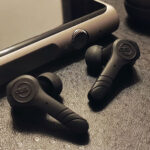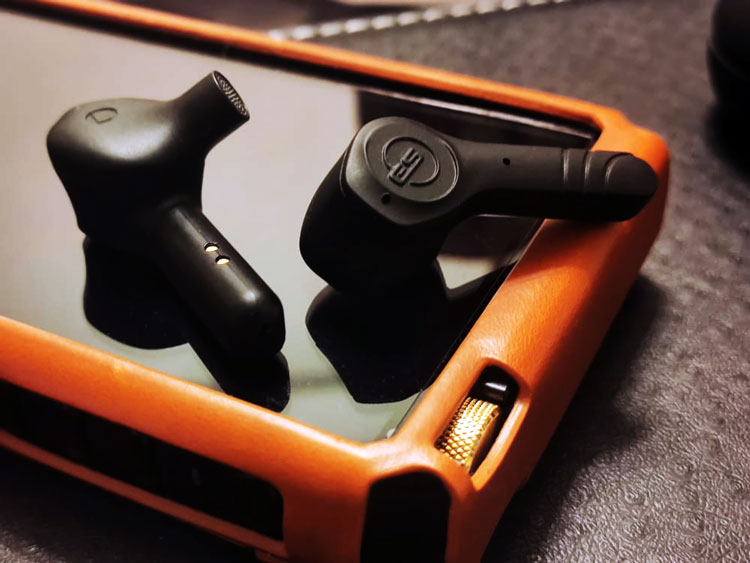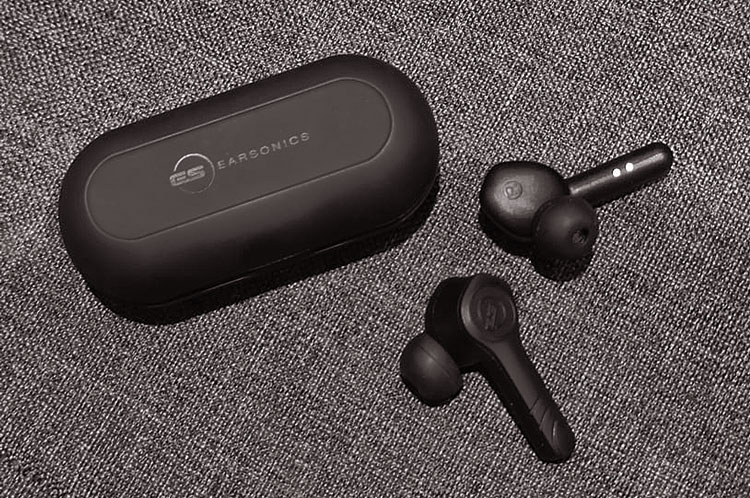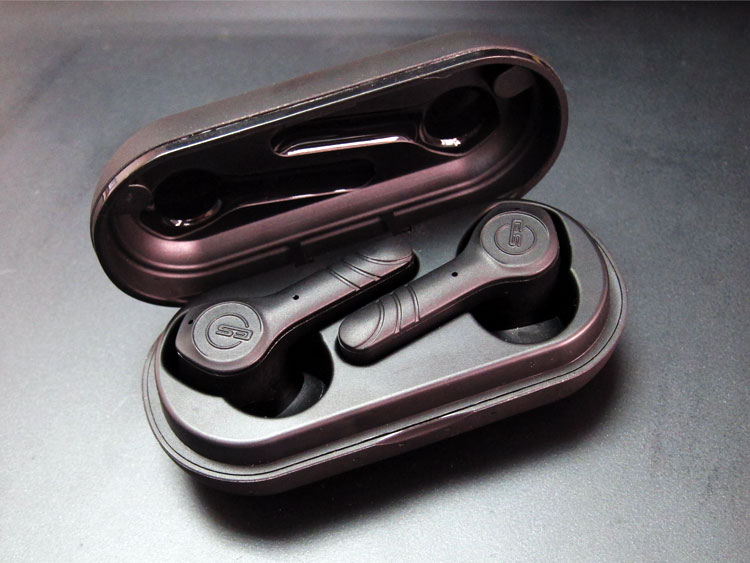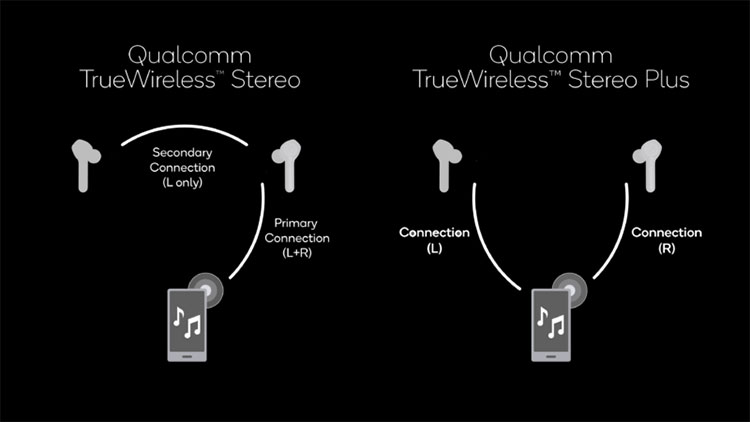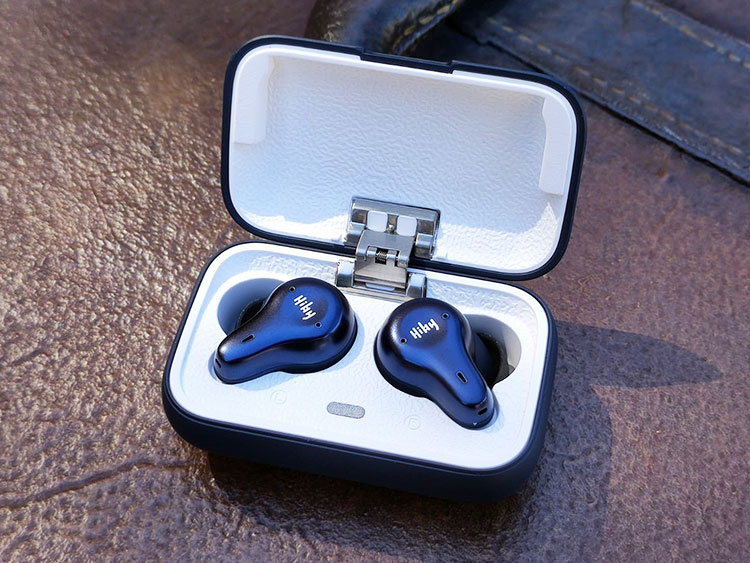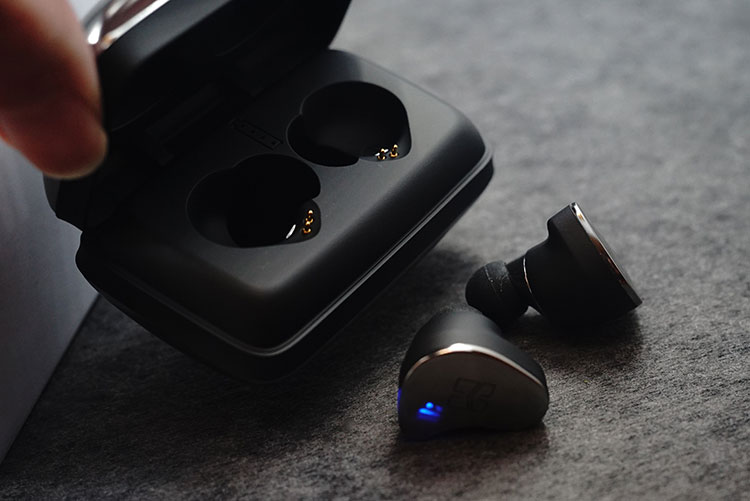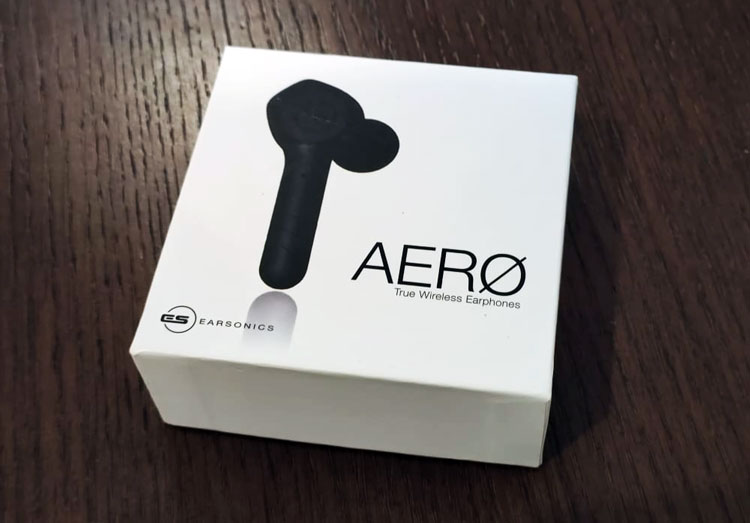The Earsonics AERO is the company’s debut TWS featuring aptX decoding, IPX4, and up to 21 hours of listening time. It is priced at €199.
Disclaimer: The Earsonics AERO sent to us is a sample in exchange for our honest opinion. We thank the team at Earsonics for giving us this opportunity.
To read more about Earsonics products reviewed on Headfonics click here.
Note, this review follows our new scoring guidelines for 2021 which you can read up on here.
After a series of fresh new wired IEM designs, French portable audio specialists Earsonics have come up with their first TWS model ‘’AERO”, targeting audiophile users and selling at €199.
The French company is building some of the best in-ears in the market so their first true wireless offering is definitely something interesting to check out. If you are already a fan you may recognize the shell being very alike Earsonics’ earlier designs, and it is incredibly lightweight and waterproof.

Tech Highlights
The touch-controlled AERO uses Qualcomm aptX technology with AEQ Active Processing with an IPX4 level waterproof design. Inside the housing, Earsonics have implemented a 6mm graphene dynamic driver with a digital processor incorporating AEQ (Active Audio Processing) algorithms.
The AERO also features fast charging technology that allows a 15 mins charge to deliver up to 2 hours of listening and provides 21 hours of listening time when fully charged. Last but not least the AERO TWS have True Wireless Stereo Plus that allows the earpieces to individually connect to the host device.
Design
The aesthetics are totally Earsonics style, with the protruding ES logos on its curvy, muscular design. You can see a similar contouring on their high-end metallic IEM as well as good insertion depth.
The feather-light 5g housing does not stress the ear at all as well as offering a secure fit. Even when I go for a jog they never fall out. Size-wise it is just right for any ears and the extended antennas do seem to offer a stable signal.
The housing material is all plastic which I originally considered not appealing, but that does help to keep the weight down which only adds to the level of comfort.
Comfort & Isolation
Compared to other TWS recently the Earsonics AERO feels a lot lighter in the ears. On the outside, the AERO may look a bit blocky in design but somehow it fits very well in the ear with no sign of pain or discomfort after 2 hours of listening.
Do make sure you are wearing it straight down or else the mids may sound hollow if the seal is broken or the insertion angle is tilted. It may take a while for you to figure out the best way to fit it but when you get to the sweet spot it sits in the ear very nicely.
There is no driver flex too but the isolation is average. With a plastic shell the isolation could have been worse, but possibly the PCB and other components inside as well as the rather deep insertion helps block some noise.
Tips
You will get 4 pairs of tips in the box with the M size tips in the box suiting me best. The quality is pretty good and the seal is decent.
The bore on the nozzle of the AERO is pretty big so this gives some flexibility for you to tweak the output by rolling the tips. I prefer using Final’s E tips or Spiral Dots which will push forward the mid-lows slightly.
Controls
Touch control on the AERO is very simple. Tap on the left to decrease volume, tap on the right to increase, double-tap to pause or play, and hitting 3 times to activate smart assistant on phone.
Holding the L or R earpieces will allow you to skip to the next or previous song. This works smoothly on phones and iPads but on a Windows PC some features may be disabled. You can also answer calls by tapping on the faceplate and it is picking up my voice pretty well.
You will get voice notice when turning on or pairing the AERO, all initiated by the touch panel where the logo is placed on the faceplates. The operation is straightforward and smooth, and the connection speed is quite fast with various devices.
With Qualcomm solutions inside plus a long antenna and full plastic housing, it is pretty safe to say the software and connection are stable. I had little if any issues with the AERO during this review process.
Cradle & Charging
The AERO comes in a dark-themed charging cradle with a USB-C port and four LEDs to show the charging status. The earphones are attached to the cradle with magnetized interiors and the case is able to give 2 extra charges to give a total of 21 hours of listening.
What makes it even handier is the ability to fast charge, putting the AERO in the cradle for 15 mins and you will be getting 2 hours of listening time.
Packaging & Accessories
Packaging of the AERO is a bit minimal which will no doubt delight the Earsonics logistics budget but maybe they missed an opportunity here, for example, a wider tips selection.
Opening the box, you will get immediate access to the charging cradle and the AERO inside. In the other small box, you will find another 3 sets of tips and a very short USB-C charging cable which I take with me to charge my players and phones.
Sound Impressions
Summary
With DSP in action, the AERO sounds very extended and tries to render a fairly large soundstage. This tuning sort of reminds me of the older Earsonics models which had a more laid-back presentation than the more resolving newer releases.
After around 20 hours of listening time, the AERO doesn’t sound lacking in bass power and it goes quite deep down the subs, with a V shape signature that brings out details in the upper strings on guitars but never sounds sibilant. You may find the sweet spot at a slightly higher volume if you want to get some more vocal presence.
Bass
The AERO can dive quite low in the bass with an airy mid-bass punch. It sounds slightly soft in the attack which adds some warmth to the tuning. There is good density and texture in the low end with a slightly long sustain, and it works really well for piano works/ bass guitar/ pops from the 70s/ BGMs.
The best match to me, is, however, violins and low-fi hip hop tracks. The bass response and spacious presentation make the AERO a great pairing when it comes to vibrating strings and harmonics, while keeping the tone quite balanced its soft attack makes string instruments sound euphonic.
Mids
The midrange is rounded, slightly recessed, and natural in tone, while the vocal is nicely separated from the backing instruments. In such cases I prefer adding some top-end boost for more clarity, or else when it comes to lighter voices it may sound a bit curtained or hollowed out.
When it comes to powerful voices there is some nice synergy with vocals sounding rather uncolored and natural in tone, with good layering as well. When listening to pops or folk songs I would prefer more weight in the mids for the vocal to stand out, but when it comes to instrumentals or guitar solos the tuning sounds just right.
Treble
The treble on the AERO is clean, controlled, and on the shy side, which is perfect for outdoor listening to compensate for ambient noise. The sweetly rounded tuning makes aggressive fast bowing very listenable. Throw anything sharp on the AERO and it won’t sound harsh, totally free from peaking.
More sparkle would be welcome to make guitars and violins a bit more exciting also adding more air to the vocals. In most cases, it helps the mids to sound sweeter and works well with every genre when listening outdoors.
Soundstage
The staging performance is what I enjoy the most on the AERO as well as its dynamics in the lower frequencies. Although the top end is slightly shy the upper treble frequencies are carefully controlled so it sounds pretty sweet listening outdoor and doesn’t curtain up the whole picture.
With most tunes, the staging is stretched wide with the vocal image slightly recessed to render more space and depth as if you are listening in a small hall. The AERO definitely has a dense, tight image that fits well into the expanded staging.
I suspect the design is tuned solely for outdoor use as the vocal image is slightly fat with the extended sustain in the bass. Listening indoors it may lack air and energy but when the noise in daily surroundings set in you will find the vocal comfortable and natural sounding.
Wireless Performance
Testing the AERO as usual in a crowded train the connection stays stable. Inside the AERO it packs Qualcomm’s AptX technology as well as their TrueWirelesss Stereo Plus technology to ensure a robust connection and enhanced battery life for either side of the earphones.
This is unlike older TWS tech that connects to one side and then the earpiece sends a signal around the head to the other side. Latency, on the other hand, can still be sensed in music games but you may have it adjusted if the game allows.
Select Comparisons
HiBy WH2
$169
Technical
The single dynamic driver WH2 from HiBy has a clear tech focus and is probably one of the most technically proficient TWS monitors with its world-first LDAC implementation. And this makes it a very different TWS IEM when they opt for the opposite side in form factor, design, and tuning concept.
Design
The design basically explains itself what the manufacturers are seeking. The HiBy WH2 is fully metallic and looks solid in design while the AERO is ready for sports and long listening sessions. The trade-off for a better look here is clear and the AERO feels like nothing in the ears and holds on to my ears much tighter.
Performance
With LDAC mode on the WH2 has a lot of detail and a more balanced sounding with its W-shaped tuning. The AERO displays more energy and fullness in the bass region and does not bring out as much presence in the mid-bass.
The detail retrieval power in LDAC mode on the WH2 is stronger than the AERO but it comes at the expense of far less battery power. When you switch to an SBC connection that yields much more playback time it does not sound as convincing.
In short, the AERO sounds more laid back, bass and subs intensive with a deeper dive and warmer, thicker image, totally unobtrusive, and is more suitable for outdoor listening but not as detailed as the WH2 when listening indoors.
The WH2 in contrast is more aggressive in bringing out details is less colored and is tuned cleaner in the treble, and does not sound as punchy and dynamic in the low end.
HIFIMAN TWS800
$299
Technical
There is some similarity in technical qualities where both IEMs do not feature the highest transmitting rate codecs and the TWS800 does not even have aptX on board. In turn, this allows more amplifying power from the TWS800 as well as battery time.
This time the AERO is more technically advanced in terms of codec support but the bigger-in-size TWS800 is nearly double in battery life.
Design
Both designs are IPX4 waterproof and when you put the two together you can see the TWS800 being a lot bigger than the AERO.
While both TWS IEMs are quite light and built fully in plastic, the Hifiman does not insert as tightly as the AERO and catches on more wind noise with its large faceplate panel. Therefore, if you are planning to use the IEMs mainly in windy outdoor environments, the AERO is much more preferable.
Performance
Putting the AERO and TWS800 head-to-head, the TWS800 is punchier than the AERO on the low end. The dynamics are also stronger on the TWS800 and it sounds very smooth and punchy in the mid-lows.
When it comes to the staging performance and treble control the AERO stands strong against the TWS800, and it is also more resolving and tighter in the treble with its DSP processing.
The TWS800 has more dynamics but the size is a lot bigger, and it sounds more analog between the two. On the other hand, the digital processing technology allows more sub-bass and treble details to be heard on the AERO when listening outdoors.
It also sounds surprisingly more natural when listening in a noisier outdoor environment. The AERO does not focus on the mids performance only but paints a bigger picture, also sounding more laid back and unaggressive.
Our Verdict
Earsonics products always have their distinct mids tuning and this time the AERO feels like a flashback of their older design that focuses on comfortable presentation than resolution and technical qualities.
The plastic housing in black theme looks cool but it feels a bit too light compared to its metallic rivals, yet it is perfect for longer listens and light as air that’s why probably they name it AERO.
I find this TWS very suitable for long listening sessions because of its unaggressive presentation. Truth be told the treble may sound subdued when listening indoor but the outdoor listening experience is awesome with the right isolation level to keep you alert of the surroundings while blocking most of the noise.
The AERO has an overall good balance in tone factoring in ambiance noise, decent mid-bass density, and a really light profile that is extremely comfortable to wear, perfect to be carried around for daily commute.
Earsonics AERO Technical Specifications
- Bluetooth 5 QUALCOMM APTX
- Profiles: HFP, HSP, A2DP, AVRCP
- Bluetooth range: 10m
- Frequencies response: 20Hz-20kHz
- Listening time: 5-7 hours*3
- Battery: 55mAh each side +300mAh li-battery
- battery life indication on smartphones


